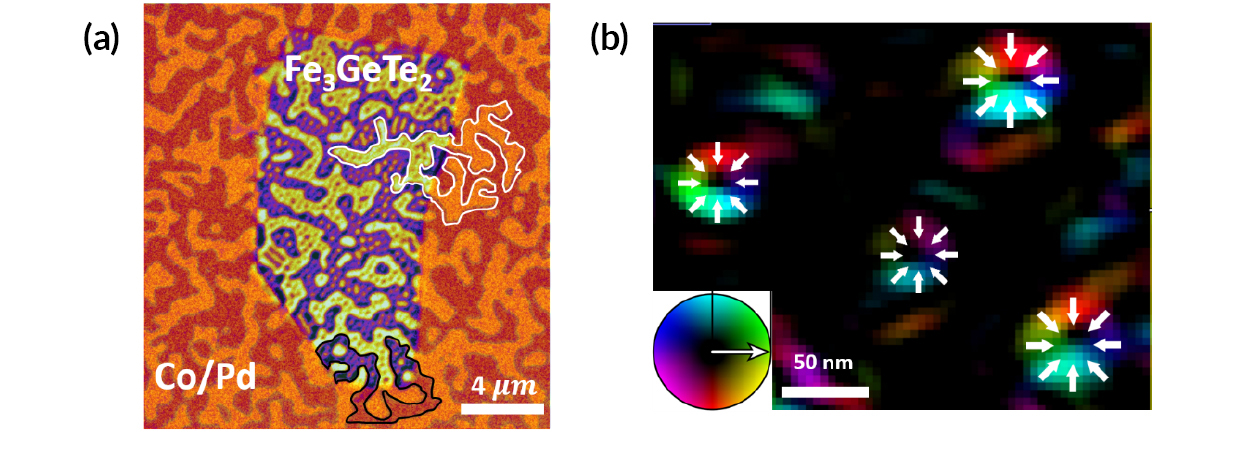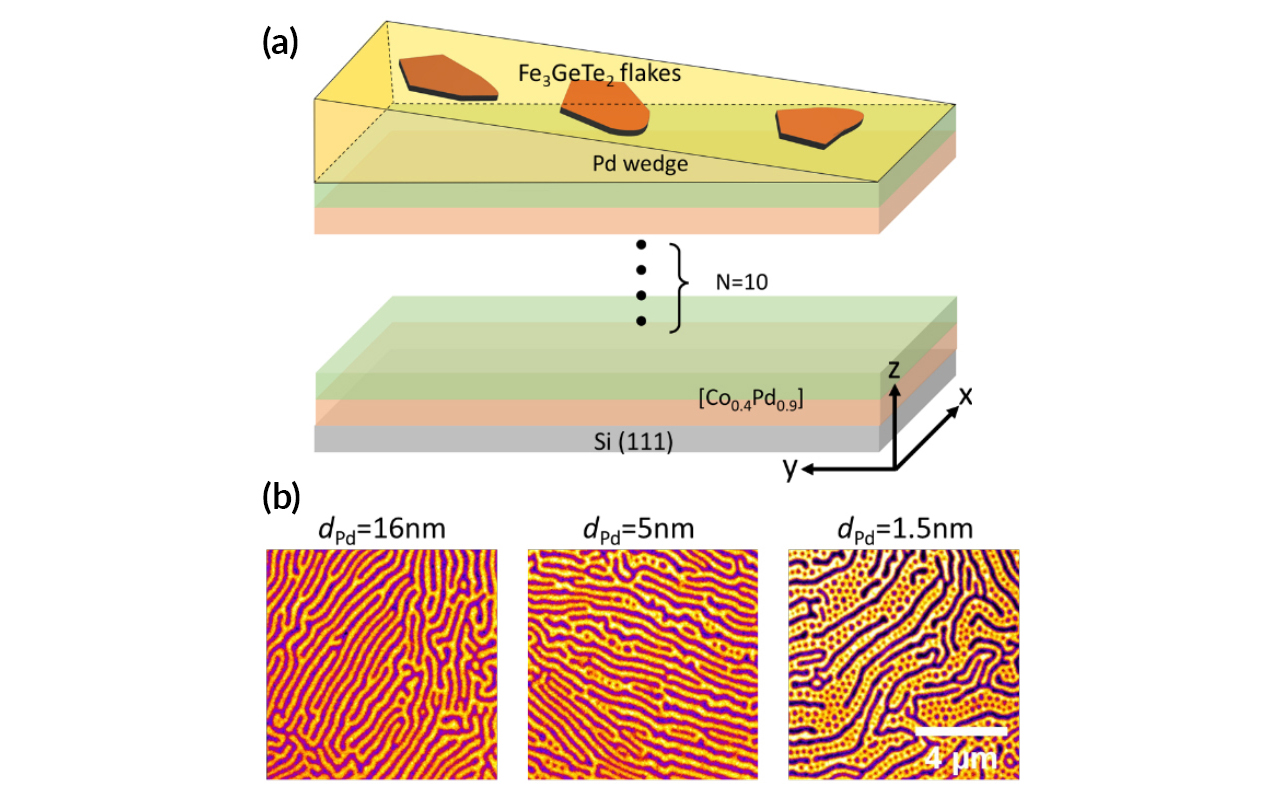SCIENTIFIC ACHIEVEMENT
Researchers using the Advanced Light Source (ALS) showed that tiny bubbles of ordered spins (skyrmions) can be induced to form in a type of material previously considered incompatible with skyrmion formation.
SIGNIFICANCE AND IMPACT
The discovery opens up a new class of material systems that exhibit technologically desirable nanoscale features attractive for spintronic applications.

Skyrmions and van der Waals materials
In spintronics research, two equally important topics have emerged in recent years: magnetic skyrmions and magnetic van der Waals materials. Magnetic skyrmions are extremely tiny and stable (i.e., “topologically protected”) swirls of spin. Their small size and high stability make skyrmions very attractive for use in high-density, low-power spintronic applications. Van der Waals (vdW) materials consist of weakly bonded, two-dimensional layers that exhibit highly tunable electronic properties. Recently, in some cases, vdW materials were also found to exhibit ferromagnetism, an exciting development that bodes well for new and potentially useful properties.
The merging of these two developments would greatly expand the possibilities for fundamental and applied research. However, because magnetic vdW materials have lacked a key structural characteristic—the breaking of inversion symmetry—necessary for the formation of skyrmions, there has been little overlap between the two subject areas. In this work, researchers show unambiguously that magnetic coupling between a vdW material and cobalt/palladium multilayers leads to the spontaneous formation of magnetic skyrmions in the vdW material, without the need for inversion symmetry breaking or an external magnetic field.
Tuning via palladium wedge
In a previous study performed at the ALS, the researchers observed long-range magnetic order in the vdW material, Fe3GeTe2 (FGT). This ordering took the form of stripe domains with out-of-plane magnetizations (i.e., equal amounts of light and dark stripes with up and down magnetizations, respectively).
Here, the researchers explored how magnetic coupling to underlying cobalt (Co) and palladium (Pd) multilayers affects the FGT spin texture. They reasoned that bringing the FGT and the Co/Pd layers closer together would increase the coupling, creating an imbalance in the areas of light and dark stripes. The stripes in the minority would decrease in size and eventually break up into bubbles (topologically equivalent to a skyrmion), circumventing the requirement for inversion symmetry breaking.
Three flakes of FGT were placed on top of Co/Pd multilayers, with a wedge-shaped Pd spacer layer in between to tune the strength of the interlayer coupling. Element-specific x-ray magnetic circular dichroism (XMCD) at ALS Beamlines 4.0.2 and 6.3.1 was used to confirm the magnetization directions of the Fe and Co layers. Element-resolved photoemission electron microscopy (PEEM) at Beamline 11.0.1.1 was used to image the materials’ magnetic domains.
Hedgehog-like Néel skyrmions
The PEEM images showed that increasing the magnetic coupling strength did indeed cause the minority stripe domains to break into magnetic bubbles, as predicted. At Berkeley Lab’s Molecular Foundry, Lorentz transmission electron microscopy (LTEM) confirmed that the spins in the bubbles formed a hedgehog-like radial pattern (Néel-type skyrmions) as opposed to a swirling vortex pattern (Bloch-type skyrmions).
The results demonstrate an effective method for inducing magnetic skyrmions in vdW magnets at zero magnetic field. More generally, by expanding the group of skyrmion host materials to include these previously unknown vdW magnets, the work opens up exciting opportunities in spintronic research and the engineering of topologically protected nanoscale features. The researchers believe that their findings will have a broad impact on both the field of skyrmion research and the field of vdW materials.

Researchers: M. Yang, Q. Li, J.D. Carlström, F. Wang, and Z.Q. Qiu (Univ. of California, Berkeley); R.V. Chopdekar, C. Klewe, P. Shafer, and A.T. N’Diaye (ALS); R. Dhall, J. Turner, and C. Ophus (Berkeley Lab); J.W. Choi (Korea Institute of Science and Technology); G. Chen (Univ. of California, Davis); Y.Z. Wu (Fudan University, China); and C. Hwang (Korea Research Institute of Standards and Science).
Funding: U.S. Department of Energy, Office of Science, Basic Energy Sciences program (DOE BES), Korea Institute of Science and Technology Institutional Program, National Research Foundation of Korea, National Science Foundation, Univ. of California Office of the President, National Natural Science Foundation of China. Operation of the ALS is supported by DOE BES.
Publication: M. Yang, Q. Li, R.V. Chopdekar, R. Dhall, J. Turner, J.D. Carlström, C. Ophus, C. Klewe, P. Shafer, A.T. N’Diaye, J.W. Choi, G. Chen, Y.Z. Wu, C. Hwang, F. Wang, and Z.Q. Qiu, “Creation of skyrmions in van der Waals ferromagnet Fe3GeTe2 on (Co/Pd)n superlattice,” Sci. Adv. 6, eabb5157 (2020), doi:10.1126/sciadv.abb5157.
ALS SCIENCE HIGHLIGHT #432